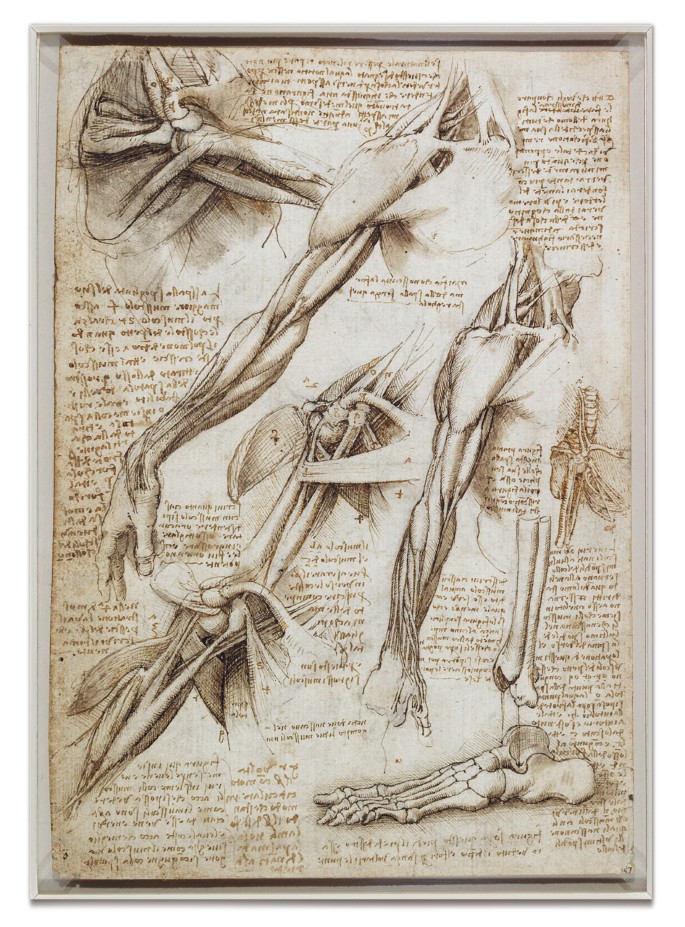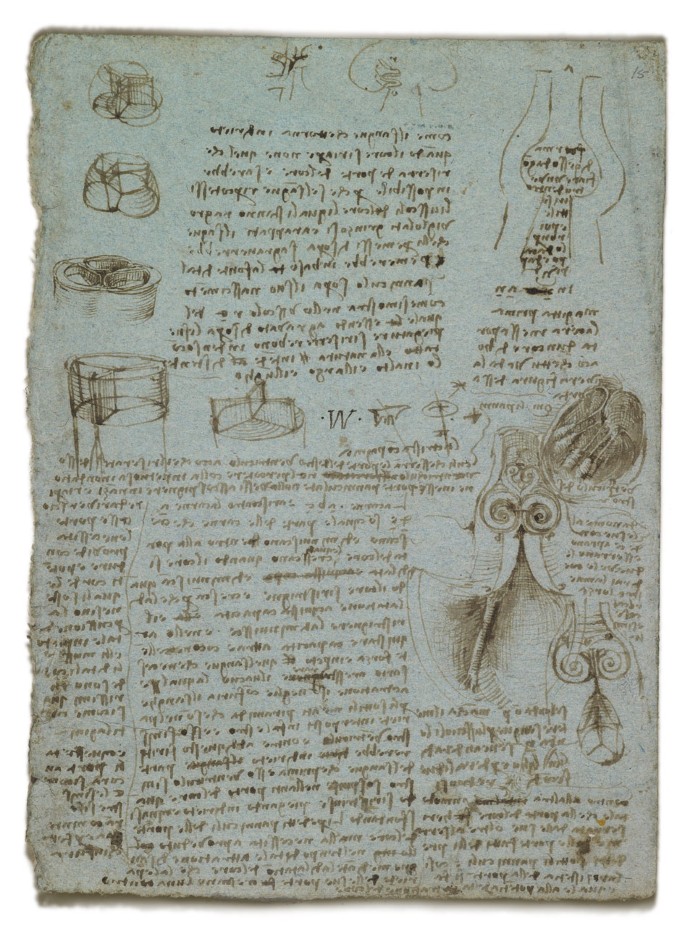Da Vinci Anatomy Drawings Book Pdf
A London exhibition will expose the Renaissance master's staggering medical discoveries, which languished unpublished for centuries, explains Martin Clayton.
Leonardo da Vinci: Anatomist
The Queen's Gallery, London. 4 May–7 October 2012. www.royalcollection.org.uk
Leonardo da Vinci is the archetype of the Renaissance man, but since his day he has been seen primarily as a painter who dabbled in the sciences. Leonardo would not have recognized this image: his scientific studies were as important to him as his art. Of all his investigations — which included optics, geology, botany and hydrodynamics — the field that engaged him most was human anatomy.
Eighty-seven of Leonardo's finest sheets of anatomical study from the UK Royal Collection's total of more than 550 by the artist are to go on show from May at the Queen's Gallery in London. They range from a fetus in the uterus to the vertebral column, and will constitute the largest-ever exhibition of Leonardo's anatomical work, and the first in the United Kingdom since 1977.
The exhibition represents two campaigns of intense work around 1490 and between 1507 and 1513, during which Leonardo dissected around 30 human corpses. He fully intended to publish his findings, and had he done so, he would have transformed the study of anatomy in Europe. Many of the bodily structures that he depicted would not be described again for centuries. But Leonardo's perfectionism, his difficulties in reconciling his observations with established beliefs about physiology, and simple bad luck prevented him from bringing his work to a conclusion.
We know little about Leonardo's early life. The illegitimate son of a notary and a peasant girl, he was born in 1452 near the town of Vinci in Tuscany, Italy. He learned to read and write but his arithmetical skills were shaky, and although he taught himself Latin as an adult, he was never comfortable with the language of most contemporary scientific writings. He was to portray this as an advantage — claiming that he was a "disciple of experience" unencumbered by ancient belief — but in reality his position outside the scientific–philosophical mainstream would deny him the range of contacts and resources that his peers enjoyed.
In his twenties, Leonardo joined the painters' guild in Florence and worked in the studio of the innovative sculptor and painter Andrea del Verrocchio, where he picked up the rudiments of engineering. Then, in the 1480s, Leonardo moved to Milan, where his range of interests widened at a remarkable rate and he began to compile material for a treatise on the theory of painting.
Leonardo had come to see painting as a scientific activity, in which every effect (light and shade, colour, perspective) and form should be based on a true understanding of nature. The human body was the principal subject of the Renaissance artist and Leonardo soon realized that he would have to devote a separate treatise to it. It was not sufficient to study the permanent anatomy of the body: Leonardo also wanted to learn how an individual's appearance from moment to moment was related to the workings of the mind, so that a painting would reveal the emotions of the protagonists and the human drama of the scene.
Leonardo thus aimed to understand the perception of reality through the senses, the structure of the mental faculties and how the nerves configure the muscles and bones. How could he even begin to investigate these topics? Human dissection was not banned, as is often supposed; indeed, a papal bull of 1482 expressly permitted it. But Leonardo was a mere craftsman, and — then as now — a craftsman could not simply acquire a corpse and start cutting it up. Instead, he was reliant at first on animal dissection, traditional belief and simple speculation.
In 1489, Leonardo obtained a human skull. He sectioned it to investigate its internal structure, recording his findings in exquisite drawings in a notebook annotated in his habitual mirror writing (Fig. 1). But the shape of the skull (and by implication of the brain) failed to provide Leonardo with any useful information about the relationship between mind and body. The gulf between Leonardo's ambitions and his achievements brought his first wave of anatomical research to a halt. In his mural The Last Supper, finished in the 1490s, the disciples' poses and expressions convincingly capture their varied emotions, but owe nothing to his anatomical investigations.

ROYAL COLLECTION TRUST/© HM QUEEN ELIZABETH II 2012
The skull sectioned (1489), one of Leonardo da Vinci's earliest anatomical studies, did not yield the insights that he craved.
Full size image
Leonardo returned to the subject years later, in the wake of a commission to paint a huge battle scene in the Palazzo della Signoria in Florence. In preparation for the project he executed many drawings of male musculature, some so detailed that they can only have been based on flayed bodies. Leonardo was then in his fifties and one of the most celebrated artists in Italy; at this point in his career, he seems to have had little difficulty in obtaining permission to dissect human corpses.
In the winter of 1507–08, Leonardo witnessed the peaceful demise of an old man in a hospital in Florence, and wrote in his notebook that he performed a dissection "to see the cause of so sweet a death". He attributed it to a narrowing of the coronary vessels, and wrote the first clear description of atherosclerosis in medical history. He also described the pathology of cirrhosis of the man's liver, which he found to be "desiccated and like congealed bran both in colour and substance".
The dissection of the old man marked the beginning of five years of intense anatomical investigation, and in 1510–11 Leonardo seems to have collaborated with Marcantonio della Torre, the professor of anatomy at the University of Pavia.
Marcantonio provided ready access to human material, and Leonardo may have dissected up to 20 corpses that winter. He concentrated on the bones and muscles, analysing their structure in purely mechanical terms, and the results were spectacular (Fig. 2). Perhaps encouraged by the professional anatomist, Leonardo illustrated every bone except those of the skull, and most of the major muscle groups. The completion of his treatise was within reach, and on one drawing he wrote: "This winter of 1510 I believe I shall finish all this anatomy".

ROYAL COLLECTION TRUST/© HM QUEEN ELIZABETH II 2012
With The muscles of the shoulder and arm, and the bones of the foot (c.1510–11), Leonardo sought to explore the dynamic interplay of bodily elements that underlay the poses of human models in his paintings.
Full size image
But it was not so. In 1511, Milan descended into military turmoil. Marcantonio died of the plague, and Leonardo retired to the country villa of his assistant, Francesco Melzi.
With the loss of his supply of human material, Leonardo reverted to the study of animal anatomy — most impressively the ox's heart, which differs little in structure from that of a human. Leonardo described the ventricles and atria with great accuracy, and analysed the structure and functioning of the valves in minute detail. In a brilliant experiment, he made a glass model of the aortic valve (Fig. 3), through which he pumped water mixed with grass seeds to study the vortices in the widening of the aortic root. He deduced that these vortices were crucial in closing of the valve — a finding that was confirmed only in the twentieth century.

ROYAL COLLECTION TRUST/© HM QUEEN ELIZABETH II 2012
The findings recorded in The aortic valve (c.1512–13) went unconfirmed for more than 400 years.
Full size image
Leonardo had an almost perfect understanding of the physiology of the human heart. But he had no inkling of the circulation of the blood, and the existence of one-way valves was incompatible with the ancient belief that the heart simply churned blood in and out of the ventricles, thus generating heat and 'vital spirit'. Unable to reconcile what he had observed with what he believed to be true, Leonardo reached an impasse. He became trapped in describing the motion of the blood through the valves in ever more detail. And there, it seems, his anatomical work came to an end.
There is no sign that Leonardo attempted to collate his research for publication. On his death in 1519 he left his papers to Melzi, and although the anatomical studies were mentioned by all Leonardo's early biographers, their dense and disorganized content was barely comprehended. Unpublished, the studies were effectively lost to the world. Elsewhere, anatomical exploration gained pace, and in 1543 Andreas Vesalius published his epochal De humani corporis fabrica (On the fabric of the human body), a model of what Leonardo's treatise could have been.
The 150 surviving sheets of Leonardo's anatomical studies reached England in the seventeenth century and eventually made it into the Royal Collection, bound into an album with 450 of his more artistic drawings. But it was not until 1900 that they were finally published and understood. By then, their power to affect the progress of anatomical knowledge had long passed.
Leonardo's paintings changed the course of European art; but his anatomical investigations, the finest of their age, were essentially unknown. This exhibition will give an unprecedented chance to assess this most paradoxical of scientists.
See Martin Clayton discussing three of Leonardo's anatomical studies on Nature Video.
Rights and permissions
About this article
Further reading
Da Vinci Anatomy Drawings Book Pdf
Source: https://www.nature.com/articles/484314a
0 Response to "Da Vinci Anatomy Drawings Book Pdf"
Post a Comment